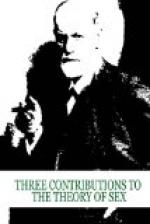The cruelty component of the sexual impulse develops in the child with still greater independence of those sexual activities which are connected with erogenous zones. Cruelty is especially near the childish character, since the inhibition which restrains the impulse to mastery before it causes pain to others—that is, the capacity for sympathy—develops comparatively late. As we know, a thorough psychological analysis of this impulse has not as yet been successfully accomplished; we may assume that the cruel feelings emanate from the impulse to mastery and appear at a period in the sexual life before the genitals have taken on their later role. It then dominates a phase of the sexual life, which we shall later describe as the pregenital organization. Children who are distinguished for evincing especial cruelty to animals and playmates may be justly suspected of intensive and premature sexual activity in the erogenous zones; and in a simultaneous prematurity of all sexual impulses, the erogenous sexual activity surely seems to be primary. The absence of the barrier of sympathy carries with it the danger that the connections between cruelty and the erogenous impulses formed in childhood cannot be broken in later life.
An erogenous source of the passive impulse for cruelty (masochism) is found in the painful irritation of the gluteal region which is familiar to all educators since the confessions of J.J. Rousseau. This has justly caused them to demand that physical punishment, which usually concerns this part of the body, should be withheld from all children in whom the libido might be forced into collateral roads by the later demands of cultural education.[19]
THE INFANTILE SEXUAL INVESTIGATION
Inquisitiveness.—At the same time when the sexual life of the child reaches its first bloom, from the age of three to the age of five, it also evinces the beginning of that activity which is ascribed to the impulse for knowledge and investigation. The desire for knowledge can neither be added to the elementary components of the impulses nor can it be altogether subordinated under sexuality. Its activity corresponds on the one hand to a sublimating mode of acquisition and on the other hand it labors with the energy of the desire for looking. Its relations to the sexual life, however, are of particular importance, for we have learned from psychoanalysis that the inquisitiveness of children is attracted to the sexual problems unusually early and in an unexpectedly intensive manner, indeed it perhaps may first be awakened by the sexual problems.




